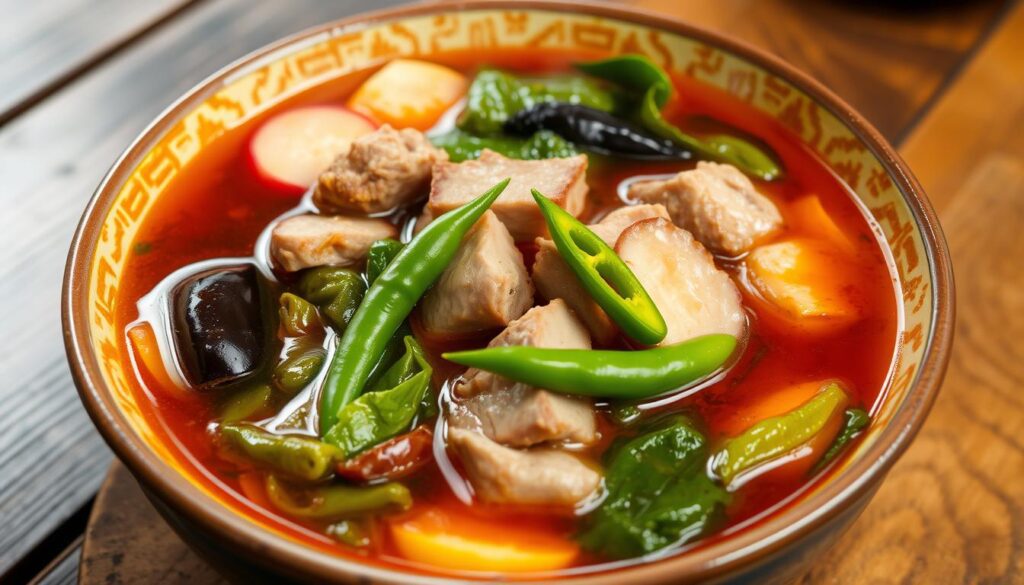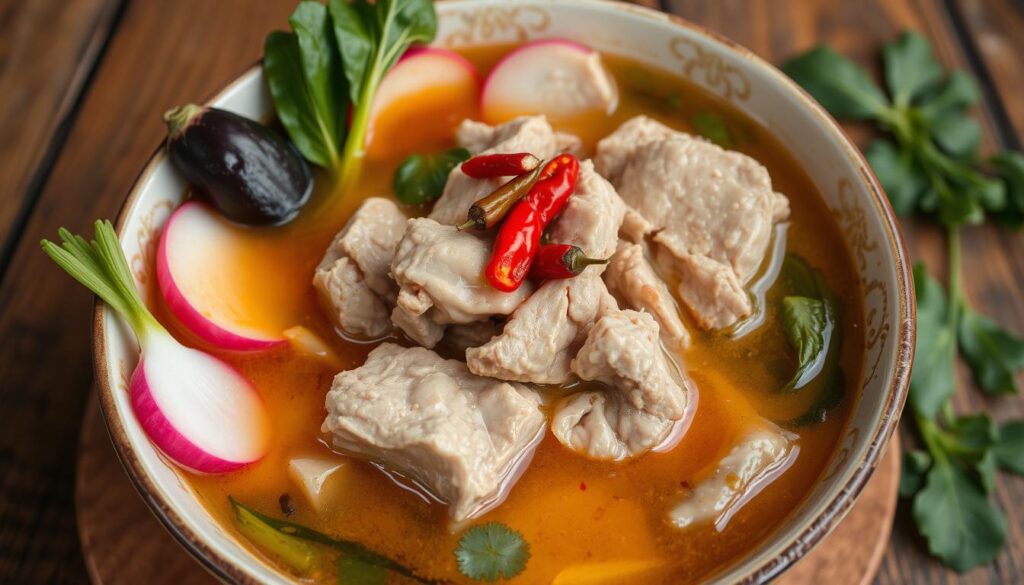Sinigang na Baboy is a traditional Filipino dish known for its tangy taste and health benefits. It’s a sour soup made with pork and fresh veggies. It’s not just a tasty meal but also supports a healthy diet.
In this article, we’ll look at how sinigang na baboy fits into a balanced diet. We’ll examine its ingredients and nutritional value. It’s a great choice for those looking to improve their diet. Let’s see how this Filipino favorite can help you reach your health goals and satisfy your taste buds.

Key Takeaways
- Sinigang na Baboy is a flavorful dish that provides essential nutrients.
- The soup is low in calories while being rich in fiber from its vegetable components.
- It offers a good source of protein, aiding in muscle maintenance.
- The dish contains health-promoting ingredients like tamarind and ginger.
- Various adaptations allow for incorporation of different proteins and flavors.
- Consultation with health professionals is recommended for dietary changes.
Introduction to Sinigang na Baboy
Sinigang na Baboy is a beloved Filipino dish known for its bold flavors. It’s a sour soup that excites the taste buds. It’s often made with pork, like pork belly, but can also have beef, shrimp, or fish.
This dish shows the Philippines’ rich culinary traditions. It uses fresh ingredients like tomatoes, tamarind, and various vegetables. Additions like kangkong, okra, radish, and eggplant make it hearty and nutritious.
For convenience, some use packaged tamarind mixes. This keeps the flavors authentic. You can also use calamansi or guava for different tastes.

Pork ribs or bony cuts add great flavor. Sinigang na baboy is not just nourishing but also comforting. It’s perfect for family meals or sharing with loved ones.
Understanding the Basics of Sinigang
Sinigang is a favorite Filipino sour soup, loved for its tangy taste and warmth. It’s perfect for rainy days. The dish uses many ingredients, showing off different cooking traditions. Tamarind is key, adding sourness and nutrition.
What is Sinigang?
The word “sinigang” means to stew, showing how it’s cooked. This soup changes a lot, depending on where it’s made and what’s available. You might find pork, seafood, beef, or veggies in it. Sinigang na baboy is a favorite, known for its rich flavor.
Key Ingredients and Variations
The main ingredients are:
- Pork Belly
- Fresh Tamarind or Sinigang Mix
- Tomatoes
- Onions
- Radish
- Spinach (Kangkong)
- String Beans
- Okra
- Chili Peppers
Every region in the Philippines has its own twist. You might find shrimp or beef sinigang. Families also add their own touches, using local produce and tastes.

The Nutritional Profile of Sinigang na Baboy
Sinigang na baboy is a favorite Filipino dish known for its nutritional value. It’s made with healthy ingredients that add flavor and nutrients. Knowing its calories and macronutrients helps us see its place in a balanced diet.
Calories and Macronutrients
A serving of sinigang na baboy has about 575 calories. This makes it a satisfying meal. Let’s look at the macronutrients:
| Macronutrient | Amount per Serving |
|---|---|
| Carbohydrates | 40 grams |
| Protein | 105 grams |
| Fat | 52 grams |
The mix of macronutrients boosts energy and supports health. Simmering keeps the dish low in unhealthy fats. It also keeps the flavors rich and hearty.
Essential Vitamins and Minerals
Sinigang na baboy is packed with vitamins and minerals. Ingredients like tamarind, tomatoes, and veggies add to its nutritional value. They provide:
- Vitamin C
- Potassium
- Calcium
- Iron
Tamarind boosts immunity with vitamins B and C. Vegetables like radish and taro add fiber and vitamins. These nutrients help with digestion and overall health.
Is Sinigang na Baboy Good for Diet?
Sinigang na baboy is a tasty choice for those looking for low-calorie meals. It uses lean pork and lots of veggies, making it filling without too many calories. This dish is great for weight management when eaten in moderation.
Low-Calorie and Nutritious
Sinigang na baboy is a standout in Filipino cuisine for its health benefits. It uses pork belly and lots of veggies, making it low in calories but high in nutrients. This mix makes it a satisfying meal that meets dietary needs.
High Fiber Content
Vegetables like kangkong, daikon radish, and snake beans boost the fiber in this dish. Fiber is good for your digestive health, preventing constipation and keeping your gut balanced. Eating fiber-rich foods like Sinigang can lower the risk of chronic diseases.
Protein Source for Muscle Maintenance
Pork is a key protein in Sinigang na baboy. This protein is vital for muscle repair and maintenance, perfect for those who are active. This dish is comforting and supports fitness goals.
| Ingredient | Calories per Serving | Protein (g) | Fiber (g) |
|---|---|---|---|
| Pork Belly (2 lbs) | 920 | 64 | 0 |
| Kangkong (1 cup) | 9 | 1 | 0.7 |
| Daikon Radish (1 cup) | 18 | 0.5 | 1.4 |
| Tomato (1 medium) | 22 | 1 | 1.5 |
| Long Green Chili Pepper (1) | 6 | 0.2 | 0.5 |
| Okra (1 cup) | 33 | 2 | 3.2 |
Health Benefits of Sinigang na Baboy
Sinigang na Baboy is not just tasty but also good for you. The mix of tamarind and ginger makes it very nutritious. It helps keep you healthy in many ways.
Boosting Immunity with Tamarind
Tamarind is a key part of sinigang. It’s full of vitamin C and antioxidants. These help your body fight off sicknesses.
Eating this dish often can boost your immune system. It’s a great choice for staying healthy.
Anti-inflammatory Properties of Ginger
Ginger in sinigang has anti-inflammatory effects. It has a compound called gingerol that fights inflammation. This is good for people with inflammatory diseases.
Ginger also makes the dish taste better. It’s a natural way to support your health over time.
Digestive Health due to Fiber-Rich Vegetables
The vegetables in sinigang na baboy, like eggplant and okra, are full of fiber. They help your digestion and keep your gut healthy. A diet rich in fiber is good for your bowels and can help with weight control.
| Ingredient | Health Benefit |
|---|---|
| Tamarind | Boosts immunity; rich in vitamin C and antioxidants. |
| Ginger | Provides anti-inflammatory effects; beneficial for inflammatory conditions. |
| Eggplant | High in fiber; supports digestive health. |
| Okra | Rich in vitamins; enhances overall nutrition. |
| String Beans | Supports digestive health; high fiber content. |
Cooking Methods and Their Impact on Health
When making sinigang na baboy, the cooking method matters a lot. It affects the dish’s health benefits. Knowing the difference between stewing and frying helps you choose better.
Stewing vs. Frying
Stewing is a healthier way to cook this traditional dish. Unlike frying, which uses a lot of oil, stewing cooks with liquid. This keeps calories and unhealthy fats low while blending flavors well.
Retaining Nutrients through Cooking Techniques
Using the right cooking techniques is key to keeping nutrients in. Methods like minimal boiling and quick steaming preserve vitamins and minerals. In sinigang, stewing is better than frying for keeping nutrients, making it a healthier choice.
Easy Sinigang Recipe to Try at Home
Make sinigang na baboy at home with this simple recipe. The mix of tamarind and fresh veggies is a perfect taste. Here’s what you need and how to cook it for a delicious meal.
Ingredients Needed
- 2 lbs of pork belly
- 3 cups of water
- 2 Roma tomatoes, cut into pieces
- 1 onion, sliced
- 1 packet of sinigang mix or fresh tamarind
- Various vegetables (e.g., okra, radish, string beans, spinach)
- Optional seasonings: fish sauce, pepper
Step-by-Step Cooking Instructions
- In a pot, add water, tomatoes, and onion; bring to a boil.
- Add the pork belly and let it simmer until tender, approximately 30 minutes.
- Stir in the sinigang mix or fresh tamarind along with all vegetables, then simmer for an additional 5-10 minutes.
- Season with fish sauce and ground pepper according to your taste. Serve hot with rice.
Common Variants of Sinigang na Baboy
Sinigang is a beloved Filipino dish known for its many variations. Each version uses different proteins, making it appealing to many. You can find it with shrimp, fish, beef, or even tofu for a vegetarian option. This shows how versatile and creative this classic dish can be.
Sinigang with Different Proteins
The protein you choose greatly affects the taste and texture of sinigang. Here are some common choices:
- Pork – Often used, it adds a rich flavor with belly or ribs.
- Fish – Fish like pompano or milkfish make it lighter.
- Shrimp – Adds a sweet touch to the sour flavors.
- Chicken – Makes it comforting and familiar.
- Beef – Beef shoulder adds depth to the broth.
Regional Variations and Their Unique Twists
Across the Philippines, sinigang has many regional twists. For example:
- Sinigang sa Miso – Adds a rich umami flavor with miso.
- Sinigang sa Bayabas – Uses guava for a sweet and fruity taste.
- Sinigang with Kamias – Features bilimbi fruit for a unique sourness.
- Knorr Sinigang Mix – Offers a convenient base in various flavors.
| Protein Type | Cooking Time | Serving Size |
|---|---|---|
| Pork | 1 hour | 4-5 servings |
| Fish | 30-40 minutes | 4 servings |
| Shrimp | 25-30 minutes | 4 servings |
| Chicken | 45 minutes | 4-5 servings |
| Beef | 1-1.5 hours | 4 servings |
These variations show off local tastes and make sinigang even more enjoyable. Each version stays true to the dish’s spirit while exploring new flavors.
Conclusion
Sinigang na Baboy is not just a tasty Filipino dish. It’s also good for your health. It’s full of vitamins, minerals, protein, and fiber. This makes it great for many diets.
The dish has tamarind and many vegetables. These add to its taste and health benefits. It’s a great choice for any meal.
Sinigang has a long history in the Philippines. It has changed over time but remains loved. Its mix of flavors and ingredients makes it perfect for a healthy diet.
Whether you love the tangy taste of tamarind or the rich flavor of pork and veggies, Sinigang is special. It offers a unique taste experience that’s good for you.
In short, adding Sinigang na Baboy to your meals is good for you. It’s not just a favorite dish. It’s also a nutritious choice that adds flavor and nutrients to your diet.
FAQ
What is Sinigang na Baboy?
Sinigang na Baboy is a sour soup from the Philippines. It’s made with pork, tamarind, and vegetables. It’s known for its unique taste and cultural importance.
Is Sinigang na Baboy healthy?
Yes, it’s a healthy choice. Use lean pork and lots of veggies. It’s full of protein and nutrients, and low in calories.
What are the main ingredients of Sinigang na Baboy?
The main parts are pork belly, tamarind, tomatoes, onions, and veggies like radish and spinach.
Can I make a vegetarian version of Sinigang?
Yes, you can. Use tofu or plant-based proteins instead of pork. Keep the sour and savory taste.
How does Sinigang benefit digestive health?
It’s good for digestion. The veggies in it are full of fiber. They help with gut health and prevent constipation.
What cooking methods are best for preparing Sinigang?
Stewing is best. It mixes flavors well without using too much oil. This keeps the veggies’ nutrients better than frying.
Does Sinigang na Baboy have any immune-boosting properties?
Yes, it does. Tamarind has vitamin C and antioxidants. These help boost your immune system and fight off sickness.
Are there regional variations of Sinigang?
Yes, there are many. For example, Sinigang sa Miso adds miso paste, and Sinigang sa Bayabas uses guava for sweetness.
How many calories are in a serving of Sinigang na Baboy?
A serving has about 575 calories. It’s a good mix of carbs, protein, and fats.

